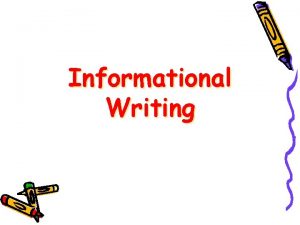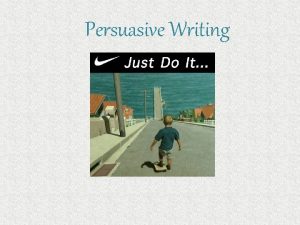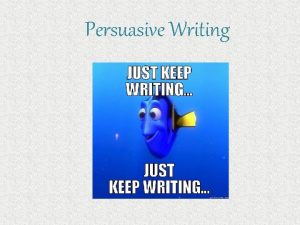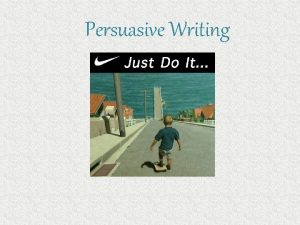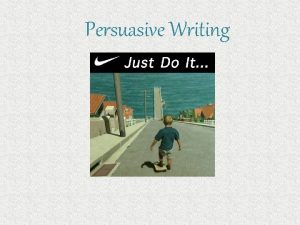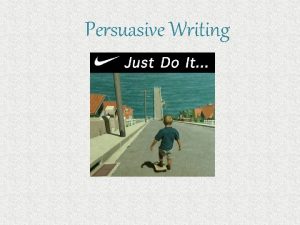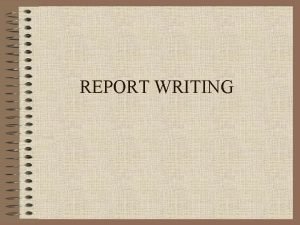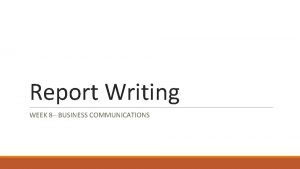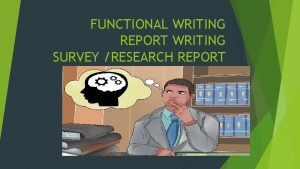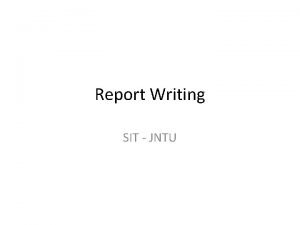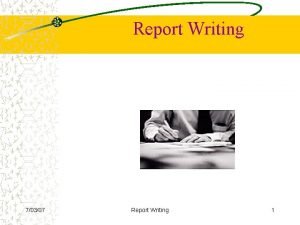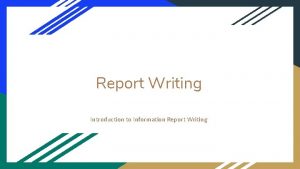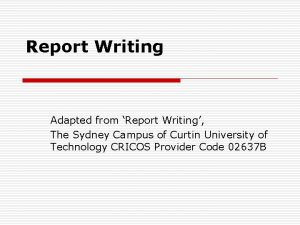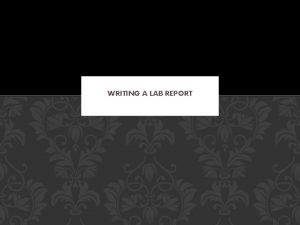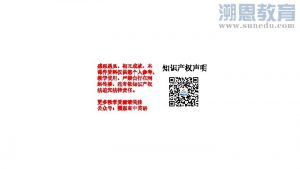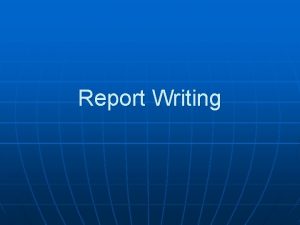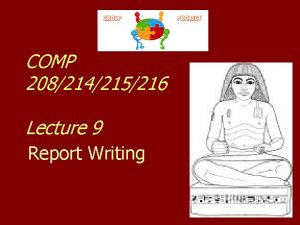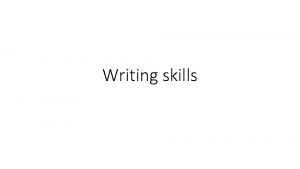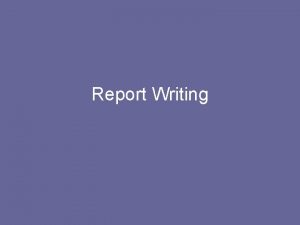Chapter 10 Writing the Report Writing the report






























- Slides: 30

Chapter 10 Writing the Report

Writing the report • Determine an appropriate report structure and organization. • Draft the report body and supplementary pages. • Use an effective writing style. • Provide appropriate documentation when using someone else’s work. • Revise, format, and proofread the report. Copyright © Houghton Mifflin Company. All rights reserved. 10 | 2

Organizing the report • Basis • • • Time Location Importance Criteria Known to unknown Simple to complex Copyright © Houghton Mifflin Company. All rights reserved. • Heading format • • • Noun phrases Participial phrases Partial statements Statements Questions 10 | 3

Making use of the data • Findings: Dana frequently misses work. He rarely reaches his quota. He doesn’t get along well with his coworkers. • Conclusion: Dana is not an effective worker. • Recommendation: Dana should be fired. Copyright © Houghton Mifflin Company. All rights reserved. 10 | 4

Report outline THE STATUS OF WORKING MOTHERS IN MANAGEMENT Janice Bellevue I. INTRODUCTION A. Purpose and Scope B. Procedures Copyright © Houghton Mifflin Company. All rights reserved. 10 | 5

Report outline (cont’d) II. FINDINGS A. Number of Working Mothers 1. National Labor Force 2. State Labor Force B. Effects on Labor Productivity 1. Absenteeism 2. Rate of Turnover 3. Commitment to the Job C. Special Needs of Working Mothers 1. On-Site Child-Care Centers 2. Flexible Working Hours 3. Family Leave Copyright © Houghton Mifflin Company. All rights reserved. 10 | 6

Report outline (cont’d) III. SUMMARY, CONCLUSIONS, AND RECOMMENDATIONS A. Summary and Conclusions B. Recommendations Copyright © Houghton Mifflin Company. All rights reserved. 10 | 7

What is wrong with this outline? I. Findings 1. Knowledge of Benefits a) Familiarity with Benefits b) Present Methods of Communication 2. Opinions of Present Benefits II. Options A. New Plan 1 a. Health Portion B. New Plan 2 Copyright © Houghton Mifflin Company. All rights reserved. 10 | 8

Body of the report • • • Introduction Background Need for the study Authorization for the report Hypotheses or problem statement and subproblems • Purpose and scope • Procedures Copyright © Houghton Mifflin Company. All rights reserved. 10 | 9

Body of the report (cont’d) • Findings • Presentation, analysis, and interpretation of the data • Tables and figures • Report headings • Documentation Copyright © Houghton Mifflin Company. All rights reserved. 10 | 10

Final section • Summary • Conclusions • Recommendations Copyright © Houghton Mifflin Company. All rights reserved. 10 | 11

Supplementary sections • • • Title page Report title Names of reader and writer Transmittal date Other relevant information Copyright © Houghton Mifflin Company. All rights reserved. 10 | 12

Supplementary sections (cont’d) • Transmittal Document • Letter or memorandum conveying the completed report • Executive Summary • Synopsis or abstract Copyright © Houghton Mifflin Company. All rights reserved. 10 | 13

Supplementary sections (cont’d) • Table of Contents • Identification of report headings • Page numbers on which the report headings are found Copyright © Houghton Mifflin Company. All rights reserved. 10 | 14

Supplementary sections • • Appendix Supplemental information References Complete citation of all sources referred to in the text Copyright © Houghton Mifflin Company. All rights reserved. 10 | 15

What are the names of these parts of a report? 1. 2. 3. 4. 5. Supplementary documents and information All sources cited in the report Report headings and pages where found Another name for an abstract or synopsis Document that accompanies a report to the reader Copyright © Houghton Mifflin Company. All rights reserved. 10 | 16

Answers 1. 2. 3. 4. 5. Appendix References Table of Contents Executive Summary Transmittal Letter Copyright © Houghton Mifflin Company. All rights reserved. 10 | 17

Writing style Tone Not: The auditor did not buy the supplier’s story. But: The auditor did not believe the supplier. Copyright © Houghton Mifflin Company. All rights reserved. 10 | 18

Writing style (cont’d) Use of pronouns Informal: I mailed the questionnaire to nearly 300 customers. Passive: This questionnaire was mailed to nearly 300 customers. Active: Nearly 300 customers received the questionnaire. Copyright © Houghton Mifflin Company. All rights reserved. 10 | 19

Writing style (cont’d) Use of pronouns Informal: I believe the cause of the problem is low morale. Formal: The cause of the problem is probably low morale. Copyright © Houghton Mifflin Company. All rights reserved. 10 | 20

Writing style (cont’d) Verb tense Not: The issue will be discussed in the next section. But: The issue is discussed in the next section. Not: The president thought the project should be canceled. But: The president thinks the project should be canceled. Copyright © Houghton Mifflin Company. All rights reserved. 10 | 21

Which sentences use the correct verb tense for a report? 1. Most of the managers believe the software program is useful. 2. These conclusions will be discussed later in the report. 3. Finding: Employees received adequate training for the new equipment. 4. Conclusion: The managers did not receive specific training. Copyright © Houghton Mifflin Company. All rights reserved. 10 | 22

Author-date documentation • • • Smith (2005) found that. . . In a recent productivity study (Smith, 2005), . . . As Smith and Jones (2007) demonstrated, . . . As has been shown (Smith & Jones, 2007), . . . Several studies (Abel, 2004, 2007 a, 2007 b; Brooks, 2001; Curtin, 2008), . . . • His answer was, “Not in your lifetime” (Dye, 2008, p. 230). • Medco sold its Akron plant for $2. 4 million (“Medco Lights Up, ” 2008, p. 14 B). Copyright © Houghton Mifflin Company. All rights reserved. 10 | 23

Using the Internet Access: http: //www. library. ucla. edu/libraries/college/help/ critical/ • Read “Thinking Critically about World Wide Web Resources. ” • Identify three items that were not familiar to you. • Print a copy for future reference. Copyright © Houghton Mifflin Company. All rights reserved. 10 | 24

When do you give credit? • When you cite unique words or ideas presented in a magazine, book, newspaper, song, TV program, movie, Web page, computer program, letter, advertisement, or any other medium • Information you gain through interviewing or conversing with another person, face to face, over the phone, or in writing • When you copy the exact words or a unique phrase Copyright © Houghton Mifflin Company. All rights reserved. 10 | 25

When do you give credit? (contd) • When you reprint any diagrams, illustrations, charts, pictures, or other visual materials • When you reuse or repost any electronicallyavailable media, including images, audio, video, or other media Bottom line: Document any words, ideas, or other content that originates somewhere outside of you. Source: Adapted from: http: //owl. english. purdue. edu/owl/resource/589/02/, accessed 10/1/07. Copyright © Houghton Mifflin Company. All rights reserved. 10 | 26

Check for parallelism • Check on each side of and or or to see if joined items are parallel. • If you have several items, put them in column form to see if they are parallel. • Listen to the sound of the items in a list or the items being compared. Do you hear the same kinds of sounds (e. g. , ed or ing)? Source: Adapted from: http: //owl. english. purdue. edu/owl/resource/589/04/, accessed 10/1/07. Copyright © Houghton Mifflin Company. All rights reserved. 10 | 27

Quiz Proofread for mechanical errors 1. Margot lives in the south. Our display window faces west. 2. table 3, page 78 3. four men and 18 women; 16 women sharing four cars 4. prefering, differred, sincerity, deciet, useable 5. 150 two page brochures, three 41 cent stamps Copyright © Houghton Mifflin Company. All rights reserved. 10 | 28

Answers 1. Margot lives in the South. Our display window faces west. 2. Table 3, page 78 3. 4 men and 18 women; 16 women sharing four cars 4. preferring, differed, sincerity, deceit, usable 5. 150 two-page brochures, three 41 -cent stamps Copyright © Houghton Mifflin Company. All rights reserved. 10 | 29

Key terms • • • conclusions direct quotation documentation executive summary generic heading Copyright © Houghton Mifflin Company. All rights reserved. • • paraphrase plagiarism talking heading transmittal document 10 | 30
 Hát kết hợp bộ gõ cơ thể
Hát kết hợp bộ gõ cơ thể Frameset trong html5
Frameset trong html5 Bổ thể
Bổ thể Tỉ lệ cơ thể trẻ em
Tỉ lệ cơ thể trẻ em Voi kéo gỗ như thế nào
Voi kéo gỗ như thế nào Tư thế worms-breton
Tư thế worms-breton Bài hát chúa yêu trần thế alleluia
Bài hát chúa yêu trần thế alleluia Các môn thể thao bắt đầu bằng tiếng nhảy
Các môn thể thao bắt đầu bằng tiếng nhảy Thế nào là hệ số cao nhất
Thế nào là hệ số cao nhất Các châu lục và đại dương trên thế giới
Các châu lục và đại dương trên thế giới Công thức tính thế năng
Công thức tính thế năng Trời xanh đây là của chúng ta thể thơ
Trời xanh đây là của chúng ta thể thơ Mật thư anh em như thể tay chân
Mật thư anh em như thể tay chân Làm thế nào để 102-1=99
Làm thế nào để 102-1=99 độ dài liên kết
độ dài liên kết Các châu lục và đại dương trên thế giới
Các châu lục và đại dương trên thế giới Thơ thất ngôn tứ tuyệt đường luật
Thơ thất ngôn tứ tuyệt đường luật Quá trình desamine hóa có thể tạo ra
Quá trình desamine hóa có thể tạo ra Một số thể thơ truyền thống
Một số thể thơ truyền thống Cái miệng nó xinh thế chỉ nói điều hay thôi
Cái miệng nó xinh thế chỉ nói điều hay thôi Vẽ hình chiếu vuông góc của vật thể sau
Vẽ hình chiếu vuông góc của vật thể sau Thế nào là sự mỏi cơ
Thế nào là sự mỏi cơ đặc điểm cơ thể của người tối cổ
đặc điểm cơ thể của người tối cổ V cc
V cc Vẽ hình chiếu đứng bằng cạnh của vật thể
Vẽ hình chiếu đứng bằng cạnh của vật thể Tia chieu sa te
Tia chieu sa te Thẻ vin
Thẻ vin đại từ thay thế
đại từ thay thế điện thế nghỉ
điện thế nghỉ Tư thế ngồi viết
Tư thế ngồi viết Diễn thế sinh thái là
Diễn thế sinh thái là
































